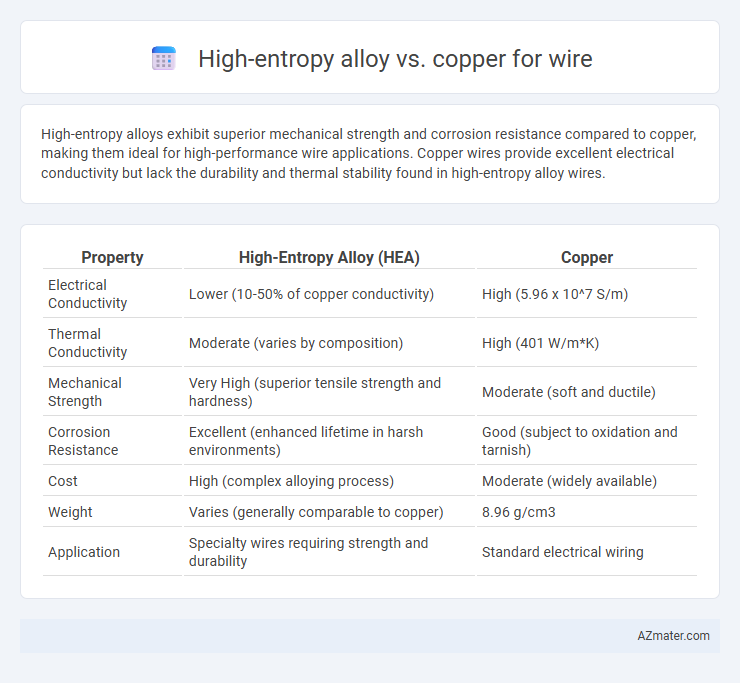High-entropy alloys exhibit superior mechanical strength and corrosion resistance compared to copper, making them ideal for high-performance wire applications. Copper wires provide excellent electrical conductivity but lack the durability and thermal stability found in high-entropy alloy wires.
Table of Comparison
| Property | High-Entropy Alloy (HEA) | Copper |
|---|---|---|
| Electrical Conductivity | Lower (10-50% of copper conductivity) | High (5.96 x 10^7 S/m) |
| Thermal Conductivity | Moderate (varies by composition) | High (401 W/m*K) |
| Mechanical Strength | Very High (superior tensile strength and hardness) | Moderate (soft and ductile) |
| Corrosion Resistance | Excellent (enhanced lifetime in harsh environments) | Good (subject to oxidation and tarnish) |
| Cost | High (complex alloying process) | Moderate (widely available) |
| Weight | Varies (generally comparable to copper) | 8.96 g/cm3 |
| Application | Specialty wires requiring strength and durability | Standard electrical wiring |
Introduction to High-Entropy Alloys and Copper
High-entropy alloys (HEAs) are advanced materials composed of multiple principal elements in near-equiatomic proportions, offering exceptional mechanical strength, corrosion resistance, and thermal stability. Copper, a traditional conductor, is renowned for its high electrical conductivity, ductility, and cost-effectiveness for wiring applications. Comparing HEAs with copper for wire performance highlights HEAs' potential for enhanced durability and wear resistance, while copper remains superior in electrical conductivity and ease of fabrication.
Historical Use of Copper in Wire Manufacturing
Copper has been the dominant material for wire manufacturing for over a century due to its excellent electrical conductivity, malleability, and corrosion resistance. High-entropy alloys, which are multi-element compositions designed for enhanced mechanical properties, are relatively new in wire applications and currently do not match copper's superior conductivity. Despite advancements in alloy technology, copper remains the industry standard for electrical wiring because of its proven performance and long-standing reliability.
Composition and Properties of High-Entropy Alloys
High-entropy alloys (HEAs) consist of five or more principal elements in near-equiatomic proportions, resulting in a stable single-phase microstructure with unique mechanical and thermal properties. Compared to copper, HEAs exhibit superior strength, corrosion resistance, and thermal stability, making them advantageous for high-performance wire applications. Their complex composition enables enhanced wear resistance and electrical conductivity tailored through element selection, contrasting with copper's relatively uniform elemental makeup.
Electrical Conductivity: High-Entropy Alloy vs Copper
Copper exhibits superior electrical conductivity, approximately 5.96 x 10^7 S/m at room temperature, making it the standard for electrical wiring. High-entropy alloys (HEAs), composed of multiple principal elements, typically demonstrate lower electrical conductivity due to increased atomic disorder and electron scattering. Despite reduced conductivity, HEAs offer enhanced mechanical properties and corrosion resistance, which can be advantageous in specialized wire applications where durability is critical.
Mechanical Strength and Durability Comparison
High-entropy alloys (HEAs) exhibit significantly higher mechanical strength and enhanced durability compared to copper, making them ideal for demanding wire applications. HEAs maintain superior tensile strength and fatigue resistance under extreme conditions, outperforming copper's comparatively softer and more ductile nature. The multi-element composition of HEAs contributes to their exceptional wear resistance and structural stability, extending wire lifespan in harsh environments.
Corrosion Resistance in Wiring Applications
High-entropy alloys exhibit superior corrosion resistance compared to copper in wiring applications due to their stable passivation layers formed from multiple principal elements, which significantly reduce oxidation and degradation in harsh environments. Copper, while highly conductive, is more susceptible to corrosion from moisture and chemical exposure, leading to potential conductivity loss and increased maintenance costs. The enhanced durability of high-entropy alloy wires ensures longer service life and reliability, particularly in industrial and marine settings where corrosion is a critical concern.
Thermal Stability and Performance
High-entropy alloys (HEAs) exhibit superior thermal stability compared to copper in wire applications, maintaining mechanical strength and resistivity at elevated temperatures above 500degC. Copper, though highly conductive with an electrical resistivity of approximately 1.68 uO*cm at room temperature, experiences significant degradation in performance and oxidation when exposed to temperatures exceeding 300degC. The enhanced thermal stability and corrosion resistance of HEAs result in improved long-term performance, making them ideal for high-temperature and harsh-environment wiring systems.
Cost Analysis and Material Availability
High-entropy alloys (HEAs) generally have higher production costs than copper due to the complexity of sourcing multiple principal elements and advanced manufacturing processes. Copper remains cost-effective and widely available, benefiting from established global supply chains and mature recycling infrastructure. Despite HEAs offering superior mechanical properties, copper's affordability and abundant material availability make it the preferred choice for most wire applications.
Potential Applications in Modern Electronics
High-entropy alloys (HEAs) offer enhanced mechanical strength, corrosion resistance, and thermal stability compared to traditional copper wires, making them suitable for high-performance electronic components in extreme environments. The superior conductivity and fatigue resistance of copper remain essential for cost-effective wiring in consumer electronics and power distribution. Emerging applications in flexible electronics, aerospace, and electric vehicles increasingly favor HEAs for their durability and reliability under thermal and mechanical stress.
Future Prospects and Research Directions
High-entropy alloys (HEAs) exhibit exceptional mechanical strength, corrosion resistance, and thermal stability, positioning them as promising candidates for next-generation wire materials beyond traditional copper wires. Ongoing research explores optimizing HEA compositions to enhance electrical conductivity while maintaining durability under extreme conditions, aiming to overcome copper's limitations in high-temperature and high-stress environments. Future prospects include developing HEA-based conductive wires for aerospace, electronics, and energy sectors, driven by advancements in additive manufacturing and nanoscale alloy design.

Infographic: High-entropy alloy vs Copper for Wire
 azmater.com
azmater.com